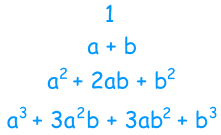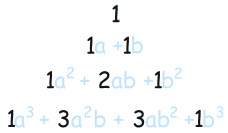Write a Blog?
Binomial Theorem
What happens when you multiply a binomial by itself ... many times?
BINOMIAL-CEPTION
BINOMIAL-CEPTION


What is a Binomial?
A binomial is a polynomial with two terms.


Multiplying
The Binomial Theorem shows what happens when you multiply a binomial by itself (as many times as you want).It works because there is a pattern ... let us see if we can discover it.
Exponents of (a+b)
Now on to the binomial.
We will use the simple binomial a+b, but it could be any binomial.
Let us start with an exponent of 0 and build upwards.Exponent of 0
When an exponent is 0, you get 1:
(a+b)0 = 1
Exponent of 1
When the exponent is 1, you get the original value, unchanged:
(a+b)1 = a+b
Exponent of 2
An exponent of 2 means to multiply by itself:
(a+b)2 = (a+b)(a+b) = a2 + 2ab + b2
Exponent of 3
For an exponent of 3 just multiply again:
(a+b)3 = (a+b)(a2 + 2ab + b2) = a3 + 3a2b + 3ab2 + b3

GETTING SMARTER
We have enough now to start talking about the pattern.
The Pattern
In the last result we got:
a3 + 3a2b + 3ab2 + b3
Now, notice the exponents of a. They start at 3 and go down: 3, 2, 1, 0:

| k=0 | k=1 | k=2 | k=3 |
| a3 | a2 | a | 1 |
| 1 | b | b2 | b3 |
an-kbk
Coefficients
| So far we have: | a3 + a2b + ab2 + b3 |
| But we really need: | a3 + 3a2b + 3ab2 + b3 |
Let's look at all the results we got before, from (a+b)0 up to (a+b)3:


THIS MAKES PASCAL'S TRIANGLE
The Original Triangle
As a Formula
Our last step is to write it all as a formula.But hang on, how do we write a formula for "find the coefficient from Pascal's Triangle" ... ?
Well, there is such a formula:
 |
It is commonly called "n choose k" because it is how many ways to choose k elements from a set of n. |
Putting It All Together
The last step is to put all the terms together into one formula.But we are adding lots of terms together ... can that be done using one formula?
Yes! The handy Sigma Notation allows us to sum up as many terms as we want:

Sigma Notation

The Binomial Theorem

Sources:
Google: https://www.google.ca/
Math is Fun: http://www.mathsisfun.com/algebra/binomial-theorem.html

O May kalderetang pinakbet ! ! JAMES you soo GOOD ! !! !!
ReplyDelete